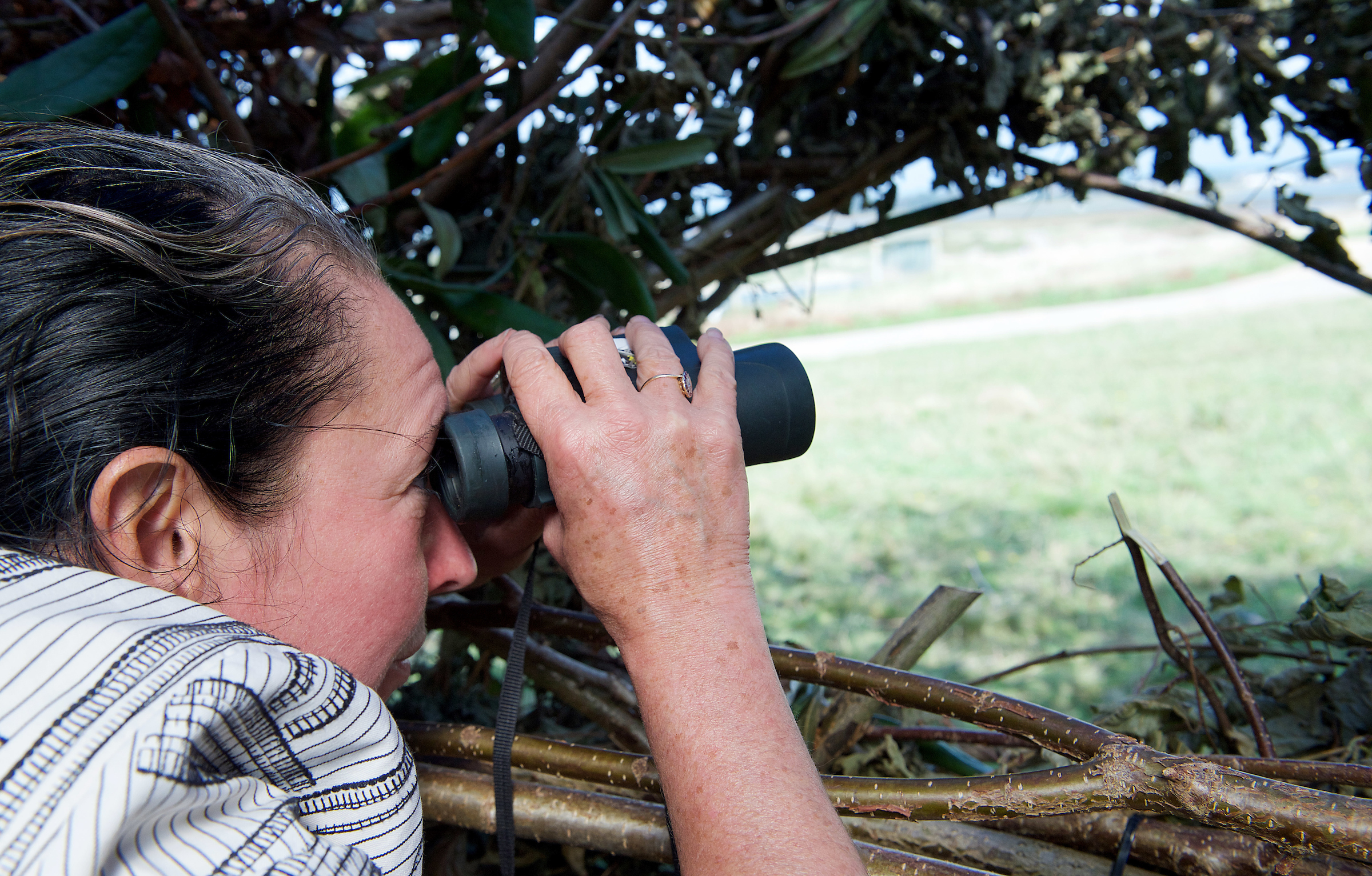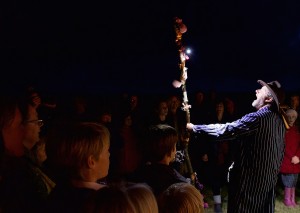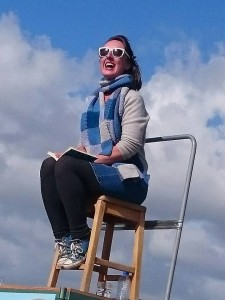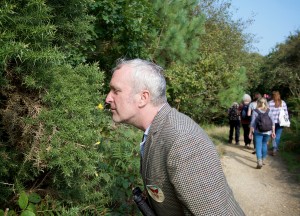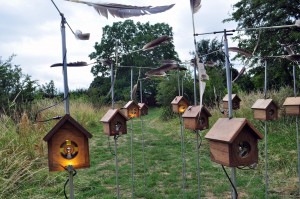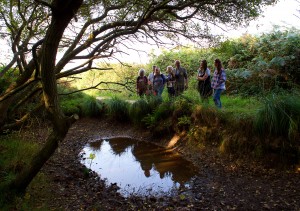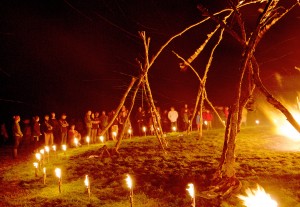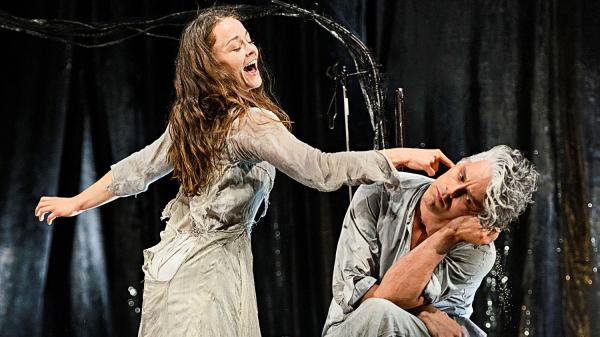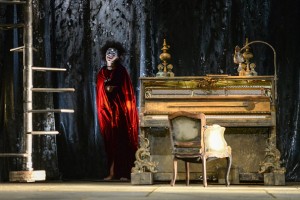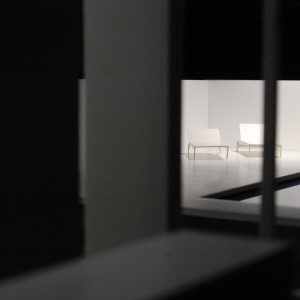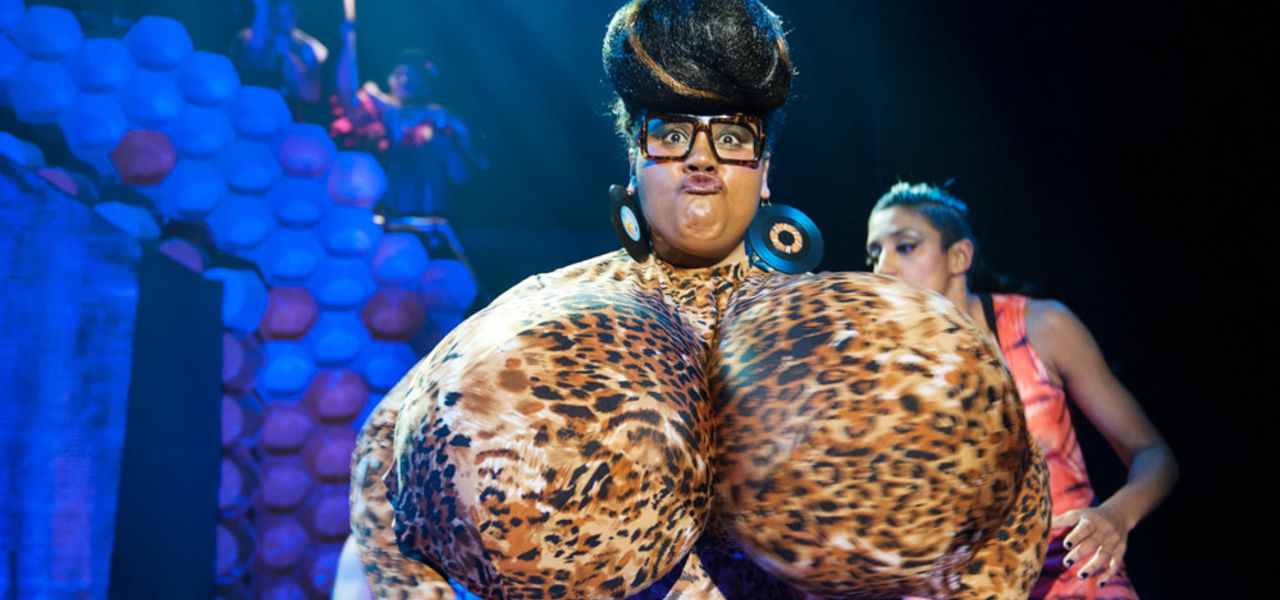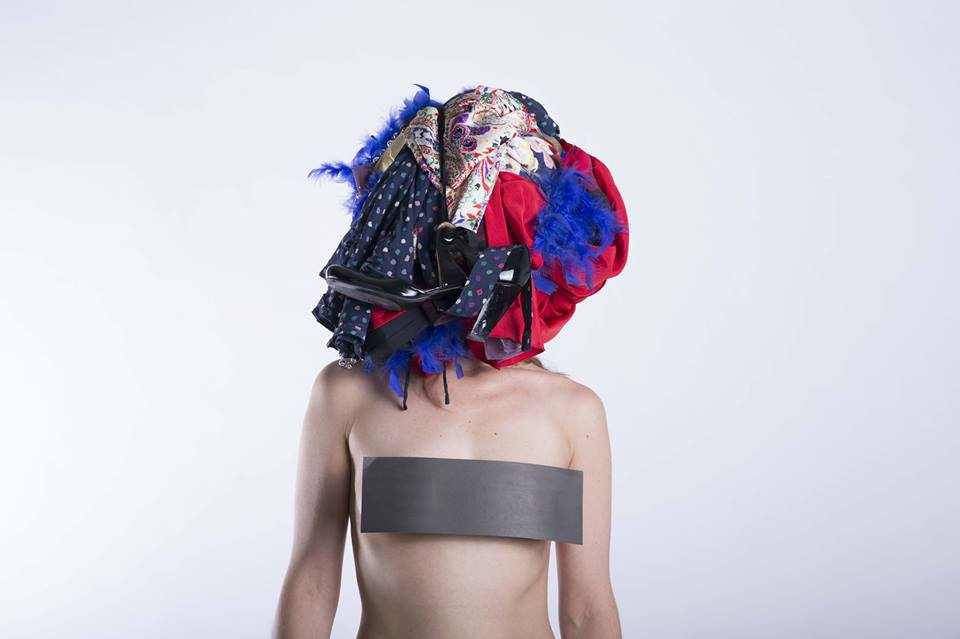Dorothy Max Prior samples some of the delights on offer at Inside Out Dorset, a ten-day festival of outdoor and site-responsive art and performance
Up the hill we climb, and climb, and climb. It’s almost, but not quite, the autumn equinox, the balance of light and dark; and it is almost but not quite dusk, the point where day meets night. We are near the village of Littlebredy, in Dorset, not so far from Dorchester. Hardy country – in both senses. Thomas Hardy country, and countryside that is robust and rugged. ‘It’s like a pilgrimage, isn’t it?’ says a man who is obviously an experienced hill walker, as he overtakes me. Walnut brown skin, dressed in shorts despite the chill of the evening, using a makeshift walking stick to propel him faster up the hill. I’m also overtaken by numerous small children, who run up the steep incline effortlessly as I huff and puff behind them, stopping often to look at the sun going down behind the trees, or to smile at the fish-on-sticks installation in a field to my right, or to note that the cars in the visitors’ car park far below are looking more and more like Matchbox toys with every passing minute.
And at last we’ve arrived, on a flat hilltop area with a panoramic view of the countryside. We’re here for Wayfaring, one of the key commissions for this year’s Inside Out, an installation and performance by artists Mandy Dike and Ben Rigby, collectively known as And Now:. Although the company was formed just three years ago, the pair have worked together for years, and both have formidable reputations, through their work as sculptors, makers and pyrotechnicians with legendary companies such as Welfare State International and The World Famous..
Night is falling fast. The hills all around us now have silver linings – yes, I do mean the hills, not the clouds. To our right, as we come over the summit of the hill we’ve climbed, we see a long avenue of hay bales, wrapped (as is the modern way) in black plastic – I think combine harvesters regurgitate them that way these days. I should have asked the farmer, Tom, who I met that evening. But as we stare down the ‘street’, wondering what might be at the other end, our attention is drawn to what’s behind us. A couple of figures are spinning fire poi in the distance, and a haze of smoke surrounds them. Out of the haze emerges a tall man – a shaman-guide, in a striped jacket and a kind of cowboy hat, bearing a stick decorated with bells that he beats into the ground. He starts to walk towards and then through the crowd, followed by a trio of musicians – a saxophone player, a tuba player, and a drummer/percussionist.
What ensues is a ritualistic journey in honour of the land. The rhythm of the earth, the passing of time, is beaten out by a chorus of around a dozen people striking stick upon stick, or stick upon bale. We move down the ‘street’, and when we get to the end and the bales fan out into two rows, we also fan out into two groups, and strip-the-willow down one row and back again. We see a man-made (or more like woman-made) copse of wooden trees and stakes and other sculptural forms, with fires burning around them. We see engorged hearts sacrificed to the land gods, and we hear a litany of thanks – to the cows, and the sheep, and the lions, and the wolves (so far, so good) and the frogs and the slugs and the wasps. The children in the crowd protest, but our shaman insists: they all have a place in this world, all creatures great and small. On cue, he and the musicians burst into a robust rendering of that well-known hymn – with the words altered to make it a secular song. We give praise to them all. And to the wheat and the corn and the oats and the barley and… Everything. Everything there is.
I remember years ago environmental art company Red Earth’s Caitlin Easterby telling me that almost everything we see as ‘natural’ in the countryside has been sculpted in some way by a human hand. I’m reminded of this here, as we overlook what seems to be untouched beauty – but there is evidence of a hill fort, there are barrows, paths, grass, trees. The land itself has ben sculpted over hundreds of thousands of years. Let’s get to the heart of the matter: our mark is clear; we leave traces.
We’ve danced around the bales, and sung the songs, and seen the sacrifice, and now the piece ends with the wooden sculpture-installation burning vigorously, and the expected whoosh of a fireworks finale. Although, for me, the fireworks are the least vital part of the evening, and I’m pleased that there is a coda: as the fireworks fizzle out, the ropes circling the installation are taken away, and we are allowed to come closer to the burning circle of wood. Now we stand quietly and peacefully, feeling the heat, watching the fire burn – as, no doubt, our ancestors did before us, perhaps on this very spot.
Bill Gee, producer and co-artistic director of Inside Out, puts an arm around my shoulders and we stare out together: ‘It’s what we do, isn’t it? Stand on top of hills at night, watching bonfires,’ he says. I’m not sure if the ‘we’ he means is the human race; or those of us who work in the outdoor arts sector – but it’s ‘yes’ to both of those in any case. As we make our way down the hill, stumbling a little in the dark, holding on to each other for support, it really does feel like we’ve been on a pilgrimage. A beautiful piece of work to mark the turning of the year.
It rains in the night. We’re woken in the morning to grey skies full of scurrying clouds, and the sound of Cooper the black labrador barking outside. We open the door of our ground-floor level BnB room to see not just Cooper but his friend Trotsky the pig keen to come in and say hello. Who could refuse a friendly pig on the doormat? I’m pleased I no longer eat pork – I wouldn’t be able to look Trotsky in the eye otherwise. So no bacon, but there are eggs for breakfast, fresh from the garden hens. They, Cooper and Trotsky all seem to co-exist quite happily. We don boots and coats, leave our digs and head off for Hengistbury Head, near Christchurch.
Hengistbury Headlines is our mission for the day – an art trail through a beautiful nature reserve on the Dorset coast that is home to over 500 plant species and 300 types of birds. As we reach the coast, the sun comes out – and stays out for the rest of the day. It is the autumn equinox, a beautiful end-of-summer day. We could have left the coats and boots behind.
Both plants and birds – and a lot more besides – feature in this marvellous cornucopia of installation and performance, much of it inspired by the site, some of it specific to this site, and all of it responding to the site in one way or another. There are eight works, and I manage to engage with most of them, although very minimally in some cases. But this is pretty good going, as some are a 40-minute walk out along the spike of the headland, and performance times overlap. I’m here on a Friday, a four-hour stint, and note that on Saturday and Sunday the event is open for six hours – which I think you’d need to see them all. All works are free to audience, although some are ticketed.
Amongst the ticketed shows is Gobbledegook Theatre’s Cloudscapes, written and performed by the company’s director Lorna Rees. This one is sited at the far end of the Head – through the woods then along the sandy beach. We arrive a little breathless, just after it starts, and are invited to each take command of one of the large, square cushions on the ground and to sit back and cloud-gaze (with sunglasses thoughtfully provided). Lorna, perched on top of an umpire’s chair above us, delivers a homily to cloud, sky and air – an eloquent train of thought with ideas that, just like the clouds themselves, form, hold steady for 10 minutes (the average life of a cloud), then disperse and reform. We learn about 18th century chemist Luke Howard, the father of meteorology, who is famed for his nomenclature of clouds, and whose work inspired Shelley’s poem The Cloud. We gaze upwards, as Lorna does at the punctuation points in her text, to a sky filled with clouds that seem to be static – but look away for a few minutes and look back, and they’ve changed shape completely. If I’d paid attention in my school geography lessons, I might be able to tell you which of Howard’s three main classification groups these big, cushiony clouds fall into – cumulus, stratus, or cirrus. We hear that René (‘I think therefore I am’) Descartes was an avid cloud-gazer, who moved from France to Holland because it had better clouds. There’s a story of a road trip with her dad that gives us some lovely anecdotes – of mushroom-cloud swimwear, and tourists told off for photographing clouds rather than rocks at the Grand Canyon. She sometimes seems to be pushing the subject matter a little bit further away from the core than it should be, yet she always reins it back in successfully, ‘self-ruining’ and rebuilding the narrative in cloud-like fashion. By inviting us to relax and listen, and to look up rather than along the horizontal plane that we mostly operate in, Lorna Rees has given us a marvellous gift. The stories she tells are beguiling and beautifully woven together, and the whole experience is delightful. Plus, there’s a kind of documentation booth (her ‘cloud box’ which is called Colin, after her grandfather) set in a horse box: the post-show icing on the cake – a repository of books, artworks, and photographs related to the project’s research and development. Lovely work!
‘To dwellers in a wood almost every species of tree has its voice as well as its feature. At the passing of the breeze the fir-trees sob and moan no less distinctly than they rock; the holly whistles as it battles with itself; the ash hisses amid its quiverings; the beech rustles while its flat boughs rise and fall.’ Thomas Hardy, Under the Greenwood Tree
Also ticketed and of fixed duration is Romantic Botanic, created by The Miraculous Theatre Company – Barnaby Gibbons, Paschale Straiton and Roger Hartley. It’s an eccentric promenade piece, and similar in this sense to the Red Herring show Funny Peculiar, an alternative tour of Brighton that Paschale Straiton made a year or two ago with Ivan Fabrega. Both shows take the form of a mis-guide to the territory, blending fact and fiction artfully. In Romantic Botanic, the subject matter is the flora and fauna of Hengistbury Head, and more specifically, the secret love life of plants. Barnaby Gibbons, in role as the tweedy countryside enthusiast Edward, is our chief guide, enthusiastically propelling us along paths and into leafy glades, stopping to invite us to admire the view or to sniff a flower here and there, or to tell us the story of Narcissus as we gaze into a pond. He’s aided and abetted by Paschale as the dotty lady scientist and devoted pagan tree-hugger Barbara, and BOSI’s Roger Hartley as the cheery Peter, a batty, blundering collector armed with AR-15 rifles, on the never-ending hunt for the (possibly mythical) Hengistbury Tuft. Barbara’s running gag about the mating of a silver birch and an oak (to create, yes, a birk) works very well, particularly as Paschale brings her character to life with her usual brilliant gusto and street-theatre sass; and the point in the piece where we come across Peter dozing by a tree that he then wires up so it can sing to us is brilliant. Some other moments and jokes drag a little, and the piece could have done with a bit of pruning, but for the most part, it’s a success. And there is a great ending, as a lily-padded pond proves to be harbouring an unexpected form of life…
Another promenade piece, although this time unaccompanied by anything other than an adventurer’s pack and a mobile phone, is Pebble Gorge’s You’re Getting Warmer – a digital treasure hunt for 7–11-year-olds and accompanying families. The children are cast as agents of change on an ecological mission to save the Marsh Warbler and stall the dreaded climate changers, the Three and a Half Degree Gang. Unfortunately, I didn’t have a 7-year-old with me, otherwise I may well have fared better. As it was, my usual curse on anything that involves auto-teatro navigation with electronic equipment kicked in – the phone froze on a cheery animation, and I had to abandon the chase. I am most definitely not the target audience for this one – but in the short amount of time I was in the game, it all seemed to be jolly good family fun, and educational to boot. I did, at least, get to find out where the Warbler lived…
There are two other performance pieces. Sweetshop Revolution’s Tree we get a sniff of – not the actual show, sadly, but we catch sight of a glorious feathered creature, a human bird who is apparently part of the team, and stop to pass the time of day with this magical being. Arbonauts (Helen Galiano and Dimitri Launder) offer The Soaring Sky, a coastal walk through a sung performance of birdsong, created by local singers who respond to the calls of migratory and endangered birds on the site. Which sounds gorgeous – but sadly it isn’t possible to get there. Kate Paxman’s Overture is a sound installation outside the former coastguard hut that sits at a high point on the Head overlooking the seas, which curve around three sides of the land. We find the hut, and walk all around the outside of it, enjoying the magnificent view, but struggle to locate the sound work. As there is such a beautiful natural soundscape here of crashing waves and calling birds, I do wonder if perhaps the artist has just ‘framed’ this spot, rather than adding to it.
Birds feature heavily in this programme. Jony Easterby (who I know mostly through his brilliant work with Powerplant, and also with his sister Caitlin’s company Red Earth, mentioned previously) has a number of installation works dotted around the Head. The works go under the collective name of Remnant Ecologies, all installation pieces running continuously, although one of the pieces, Do Not Feed the Birds, co-commissioned by the Royal Society for the Protection of Birds (RSPB), seems to have a cycle of 25 minutes duration – a series of sound installations triggered by ‘algorithms, the wind and sun, and birds themselves’. What we actually see and hear is an assemblage of deconstructed birdboxes, from which emanate a beautiful, symphonic ‘composition’ of birdsong. I pass by numerous times in the afternoon to see and hear this beautiful piece of work, and note that adults, children and dogs all seem equally enchanted by what they are hearing. Elsewhere across the Head, Jony has triggered trees to sparkle with green lights and sing with sampled birdsong, and in a densely wooded area, installed an extraordinarily exotic medley of bird and animal noises. I think I hear monkeys but that might be my over-active imagination.
Also bird related is Ferdinando Bernstein Byrne’s Hides. Two very different hides are located on a cliff overlooking the beach. One is like an enormous nest; a great big donut of twigs and leaves, which the visitor can enter to sit awhile. Inside are an assortment of strategically placed objects that hold echoes of past days – the glory days, perhaps, of Victorian and Edwardian adventurers and explorers. A pair of binoculars in a leather case, a small birdcage, an oil-burning lantern, balls of twine, framed paintings of flying ducks… Even closer to the cliff edge is a square, whitewashed, open-sided hut, wallpapered with maps showing migratory routes not of birds but of human beings, with an accompanying low-volume soundtrack of recorded voices. Dotted below is a ‘path’ of fluorescent orange lifejackets, going from the edge of the sea all the way along the beach and up the cliff to this second ‘hide’. There seems to be a story here that contrasts those who choose to cast themselves away from home comforts in the quest for exploration and discovery, and those who have no choice but to be cast out from their homes, to seek refuge elsewhere. One seeks to hide amongst the birds to watch them, the other finds themselves following the paths of the migrating birds, travelling far across the sea. Hides is a thought-provoking piece of work that I wanted to really stay with and investigate more fully. But sadly the day is drawing to an end…
Had I not had to leave, there was also the option to take part in an RSPB Big Wild Sleepout at Hengistbury Head that night, to include campfire cooking, ‘nocturnal adventures’, and a memorable dawn experience as sounds of the harbour, sea and wind combine with the song of migrant birds. Plus, a special sunrise Fl-utter-ances walk with artist Jane Pitt.
Elsewhere in the 2016 Inside Out programme, Ray Lee’s monumental sound and light sculpture, Chorus, opened the season at Portland. The programme also included a number of circus performances, such as the darkly comic Le Cirque du Platzak which charmed audiences at Gillingham. A whole day at Poole on the closing Saturday, entitled Up in the Air, featured works that included Acrijou’s dance-acrobalance duet All At Sea, the Bullzini Family’s high-wire spectacle Equilibrius, and the crowd-pleasing drumming and pyrotechnics show Sparks! by World Beaters.
All in all, an impressive ten days’ worth of works that animated the towns and countryside of Dorset, showing the magnificent range of artistic expression that comes under the Outdoor Arts umbrella – from circus, to street theatre, to environmental art, to sound installation, to promenade performance, and beyond. And all of it free to audience, in keeping with the ethos of this sector of work.
I would have loved to have seen it all, but very happy with what I managed to get to. The two days I spent in Dorset with Inside Out gave me the opportunity to really engage with the (psycho, mytho) geography of the place through the artworks on offer; to walk in the footsteps of Thomas Hardy and meet and listen to ‘trees, waters and mists, shades and silences, and the voices of inanimate things.’
The quote in the last paragraph is from Thomas Hardy’s Tess of the D’Urbervilles
Featured photo (top of page) is Ferdinando Bernstein Byrne: Hides, on site at Hegistbury Head. Photo by Elliott Franks http://elliottfranks.photoshelter.com/
Inside Out Dorset took place 14–25 September 2016, at various locations in Dorset. Co-artistic directors are Bill Gee and Kate Wood. www.insideoutdorset.co.uk
Inside Out is the flagship event of producers Activate Performing Arts: www.activateperformingarts.org.uk
Thank you to Martha Oakes PR for their help and support, and to Martha for company on the journey.

